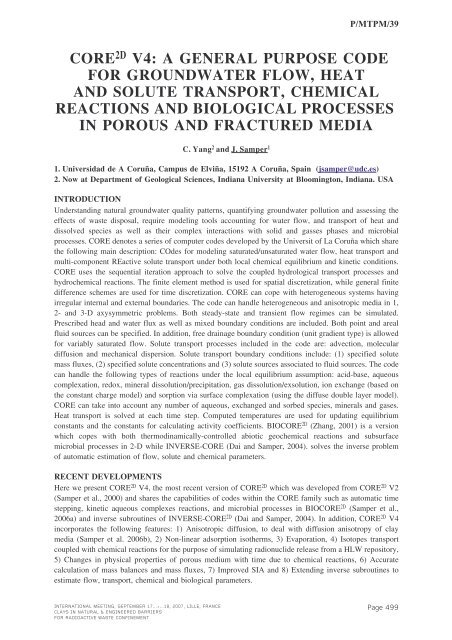Mass Transfer & Porous Media (MTPM) - Andra
Mass Transfer & Porous Media (MTPM) - Andra
Mass Transfer & Porous Media (MTPM) - Andra
You also want an ePaper? Increase the reach of your titles
YUMPU automatically turns print PDFs into web optimized ePapers that Google loves.
P/<strong>MTPM</strong>/39CORE 2D V4: A GENERAL PURPOSE CODEFOR GROUNDWATER FLOW, HEATAND SOLUTE TRANSPORT, CHEMICALREACTIONS AND BIOLOGICAL PROCESSESIN POROUS AND FRACTURED MEDIAC. Yang 2 and J. Samper 11. Universidad de A Coruña, Campus de Elviña, 15192 A Coruña, Spain ( jsamper@udc.es )2. Now at Department of Geological Sciences, Indiana University at Bloomington, Indiana. USAINTRODUCTIONUnderstanding natural groundwater quality patterns, quantifying groundwater pollution and assessing theeffects of waste disposal, require modeling tools accounting for water flow, and transport of heat anddissolved species as well as their complex interactions with solid and gasses phases and microbialprocesses. CORE denotes a series of computer codes developed by the Universit of La Coruña which sharethe following main description: COdes for modeling saturated/unsaturated water flow, heat transport andmulti-component REactive solute transport under both local chemical equilibrium and kinetic conditions.CORE uses the sequential iteration approach to solve the coupled hydrological transport processes andhydrochemical reactions. The finite element method is used for spatial discretization, while general finitedifference schemes are used for time discretization. CORE can cope with heterogeneous systems havingirregular internal and external boundaries. The code can handle heterogeneous and anisotropic media in 1,2- and 3-D axysymmetric problems. Both steady-state and transient flow regimes can be simulated.Prescribed head and water flux as well as mixed boundary conditions are included. Both point and arealfluid sources can be specified. In addition, free drainage boundary condition (unit gradient type) is allowedfor variably saturated flow. Solute transport processes included in the code are: advection, moleculardiffusion and mechanical dispersion. Solute transport boundary conditions include: (1) specified solutemass fluxes, (2) specified solute concentrations and (3) solute sources associated to fluid sources. The codecan handle the following types of reactions under the local equilibrium assumption: acid-base, aqueouscomplexation, redox, mineral dissolution/precipitation, gas dissolution/exsolution, ion exchange (based onthe constant charge model) and sorption via surface complexation (using the diffuse double layer model).CORE can take into account any number of aqueous, exchanged and sorbed species, minerals and gases.Heat transport is solved at each time step. Computed temperatures are used for updating equilibriumconstants and the constants for calculating activity coefficients. BIOCORE 2D (Zhang, 2001) is a versionwhich copes with both thermodinamically-controlled abiotic geochemical reactions and subsurfacemicrobial processes in 2-D while INVERSE-CORE (Dai and Samper, 2004). solves the inverse problemof automatic estimation of flow, solute and chemical parameters.RECENT DEVELOPMENTSHere we present CORE 2D V4, the most recent version of CORE 2D which was developed from CORE 2D V2(Samper et al., 2000) and shares the capabilities of codes within the CORE family such as automatic timestepping, kinetic aqueous complexes reactions, and microbial processes in BIOCORE 2D (Samper et al.,2006a) and inverse subroutines of INVERSE-CORE 2D (Dai and Samper, 2004). In addition, CORE 2D V4incorporates the following features: 1) Anisotropic diffusion, to deal with diffusion anisotropy of claymedia (Samper et al. 2006b), 2) Non-linear adsorption isotherms, 3) Evaporation, 4) Isotopes transportcoupled with chemical reactions for the purpose of simulating radionuclide release from a HLW repository,5) Changes in physical properties of porous medium with time due to chemical reactions, 6) Accuratecalculation of mass balances and mass fluxes, 7) Improved SIA and 8) Extending inverse subroutines toestimate flow, transport, chemical and biological parameters.INTERNATIONAL MEETING, SEPTEMBER 17...>...18, 2007, LILLE, FRANCECLAYS IN NATURAL & ENGINEERED BARRIERSFOR RADIOACTIVE WASTE CONFINEMENTPage 499
















